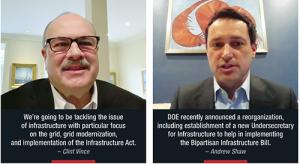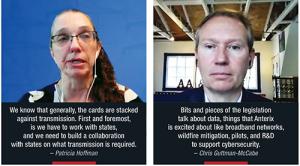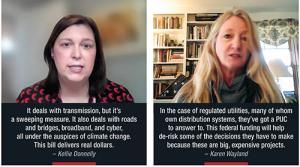Dentons
Dentons partnered with the Keystone Policy Center in late February to hold its Smart Cities and Connected Communities Think Tank with Keystone's Key Conversations. The virtual gathering is held to bring conversations with top energy leaders, policymakers, and key stakeholders, to explore issues and emerging challenges affecting energy and the environment.

The Infrastructure Investment in Jobs Act or IIJA, bipartisan infrastructure legislation signed into law last year, made a priority of historic investments in our nation's infrastructure. In the IIJA, Congress and the Biden administration recognized energy infrastructure as critical to our nation's future and provided over sixty billion dollars in supplemental funding for the Department of Energy.
Modernizing the electricity grid is a key part of the IIJA's energy investments, and this virtual roundtable of experts investigated implementation of the IIJA. The in-depth discussion answers a lot of important questions. Enjoy these excerpts.
Chair, Dentons US Energy Practice, Clint Vince: We're going to be tackling the issue of infrastructure with particular focus on the grid, grid modernization, and implementation of the Infrastructure Act.
Moderator and Partner, Dentons, Andrew Shaw: It'd be great to get some brief comments on the importance of the Bipartisan Infrastructure Bill.

Principal Deputy Ass't. Secretary, Office of Electricity, DOE, Patricia Hoffman: The Bipartisan Infrastructure Law is an investment in our nation's infrastructure and in job creation. It is a key part of President Biden's Build Back Better agenda.
This provides sixty-two billion dollars for DOE to work on a clean energy plan for the future, but also advance multiple aspects of our energy infrastructure. That includes manufacturing, jobs, and clean energy deployment, but it also includes advancing our electric grid. We want the electric grid to be the platform for innovation moving forward.
CEO, Gridwise Alliance, Karen Wayland: There's been a lot of focus on the need to build our transmission, both for resilience, reliability, and to integrate utility scale renewables, but less attention focused on the distribution system.
That's particularly important when we're talking about smart cities, is that the electricity system is changing rapidly but not fast enough to keep up with the functions we want that grid to deliver, both from distributed energy resources and utility scale renewables, but also cybersecurity, physical threats, and other things coming at the grid, like transportation electrification.

This Bipartisan Infrastructure Law has a significant amount of federal dollars that will leverage private capital to accelerate what we need in terms of modernizing the grid. Many of these decisions are made at the state level.
In the case of regulated utilities, many of whom own distribution systems, they've got a Public Utility Commission they have to answer to, or it may be the ratepayers, and the owners of public power. This federal funding will help de-risk some of the decisions they have to make because these are big, expensive projects. We will see, over the next five years of spending, an acceleration of the modernization.
EVP, Lot Sixteen, Kellie Donnelly: The IIJA is incredibly important. It's a nearly one trillion-dollar package, and it was passed in the Senate on a bipartisan basis. It's a big deal in a fifty-fifty Senate.
It deals with transmission, but it's a sweeping measure. It also deals with roads and bridges, broadband, and cyber, all under the auspices of climate change. This bill delivers real dollars. It's not just an authorization bill, but an appropriations measure.

Chief Regulatory and Communications Officer, Anterix, Chris Guttman-McCabe: What I'm excited about is we all agree the grid is at an inflection point with transmission, distribution, and all of the above. Expectations are changing — resiliency, redundancy, and dealing with climate change. All of these are resulting in new requirements on the grid.
The infrastructure legislation recognizes it. I anticipate that the assistant secretary and the team at the department are going to use these funds to do something transformational. That's key to me. This is a vehicle to modernize our infrastructure.
Dentons' Andrew Shaw: DOE recently announced a reorganization, including establishment of a new Undersecretary for Infrastructure to help in implementing the Bipartisan Infrastructure Bill. Assistant secretary, discuss the importance of this reorganization.
DOE's Patricia Hoffman: I will reemphasize that the IIJA, the Infrastructure Investment and Jobs Act, is going after strategic, transformational, lasting investment.
The establishment and new structure that the department is putting in place is optimizing our expertise, our ability to pull all the options we have to tackle the investments needed as we continue to drive clean energy, resiliency, and think infrastructure investments we need for the future, as we want to empower states and communities.
We'll bring together all the new programs that have been provided through the Bipartisan Infrastructure Law. We will work together with our states and communities and think about the tools we need to catalyze economic development.
Under this new structure, we will have a Secretary for Science and Innovation, who will continue to work on the R&D portfolio, to develop next generation technologies and capabilities in the national laboratories in support of this mission.
Then there will be an Undersecretary for Infrastructure who's going to focus on strategic capabilities from managing large-scale demonstration and deployment programs and bringing technologies to the marketplace.
We're going to hire. We have established the Clean Energy Corps. It's a portal and website for folks to join the department, but also to become part of this exciting opportunity in looking at a transformation with infrastructure funding. This is not a short-term infusion of funding. It is an opportunity to be strategic and transformational.
Dentons' Andrew Shaw: As DOE moves forward in implementing the Bipartisan Infrastructure Bill, what are some of the key questions the department should be considering?
Anterix's Chris Guttman-McCabe: For the folks who haven't been living this piece of legislation for the last many months, to give you a sense of the scale and scope, the White House guidebook is four hundred and sixty-five pages long, so that's supposed to be your sweet short, to-the-point, summary of the legislation.
There are more than sixty programs and greater than sixty billion dollars in place. From a macro perspective, there is an underpinning theme of the programs that have funds attached to them. It may be strategic and transformational, and that's great. That will help folks who want to apply, to be able to shape their application.
At the micro level, there are hundreds of questions that come up, but some of the higher-level ones are, how do the programs interrelate with one another? Some of them will probably start earlier than others, but if you do a Venn diagram, you see words like resilience, modernize, data, across a multitude of the programs.
One of the key issues the department's going to have to tackle is how do those interrelate? Particularly if one starts before another, is an applicant going to have to check a box in only applying for program A, even though what they're trying to get supported might flow across a multitude of programs?
There are questions not only within the department of, how does an application work within different programs, but then you have different agencies. The Department of Transportation, NTIA at Department of Commerce; there are ways a single project could flow across different programs within DOE and then across programs outside of the department. Being able to understand and tackle those will be key for the team at DOE.
Gridwise Alliance's Karen Wayland: This is a multi-year appropriations bill. There're potentially five years for some programs where there'll be funding coming out of the agencies.
For potential applicants like our members, particularly the utilities that have long-term investment plans, knowing what might be funded in year one, in year two, what might be funded in the out years, would be important visibility for potential applicants to have. So, they know how to line up their projects around the kinds of funding opportunities they may see coming out of DOE.
DOE's Patricia Hoffman: I would add to that conversation to read some of the provisions that you're interested in applying for funding or you think you want to apply for funding under.
There are some requirements in certain positions. Other provisions have a lot of flexibility. Meet the requirements that have been established by statute. That's something we need to keep in mind as folks start thinking about cost-share requirements.
Certain provisions have strong matching funds cost-share requirements, the SGIG, the investment grant-type provisions, which is 40107. The resiliency provision has a matching cost share, which is 40101, but it also has a requirement that funds are capped at the last three years' worth of investments and resilience.
This is going to have to be a holistic effort. It is going to require partnerships that folks may not have thought about before, which is working with states, state energy offices, communities, and figuring out what are some of those priorities folks want to look at from a transformational point of view.
We want to think about reducing that burden on states and applicants. Especially if it's a small utility or a small community, how do we ensure that funding can get to folks but not be a burden to them from a reporting requirements point of view?
Dentons' Andrew Shaw: There is interest in provisions that would bolster the federal government's backstop authority to approving transmission projects located in National Interest Electric Transmission Corridors. Can you provide some insight as to how DOE might exercise this new authority?
DOE's Patricia Hoffman: The department's trying to take a whole of government, but also all of our authority in getting transmission built. This is a sticky wicket. We know that generally, the cards are stacked against transmission.
We need transmission to capitalize on all the renewable energy resources. We need to have that capacity and ability to send renewable energy developed in, say, the midwest to the load centers.
First and foremost, is we have to work with the states, and we need to build a collaboration with the states on what transmission is required. That is getting everybody to understand transmission planning. What are ISOs and RTOs doing with respect to transmission?
We have as part of the Bipartisan Infrastructure Law, two and a half billion dollars in a borrowing authority that will allow transmission developers to come to the department with three types of applications.
One is a loan, the other one is allowing us to buy capacity on a transmission line to get that across the finish line, and the third is to directly invest in transmission projects. We are going to use all our authorities but recognizing the National Interest Electric Transmission designation, is still an authority we have.
It is an authority of last resort. We want to be able incentivize, to have stakeholders come together and build transmission projects just because we know how important it is for a reliable, resilient electric grid.
Dentons' Andrew Shaw: Assistant secretary, you made some news talking about early wins in the grid and transmission funding. Can you provide some more context?
DOE's Patricia Hoffman: The early win is we do have some existing infrastructure. How can we maximize the capacity on the existing infrastructure?
A lot of discussion is around building new transmission lines and new transmission projects. Don't forget how we can expand existing capacity opportunities. Things like reconductoring, increasing the voltage on existing rights of ways, is an opportunity.
The other opportunities are grid-enhancing technologies, which are dynamic line ratings or power flow technologies that will allow for grid operators to increase capacity on the transmission system. I don't want us to spend every moment of our time thinking about new transmission lines.
Dentons' Andrew Shaw: Beyond transmission, what other opportunities with respect to the implementation of the Infrastructure Bill do you see to modernizing the grid?
Gridwise Alliance's Karen Wayland: There are at least twenty-billion dollars available that owners of distribution systems can apply for. There are two programs totaling eleven billion dollars for funding for resilience and with one billion dollars set aside specifically for small and medium utilities. There's the three billion dollars in smart grid investment grants with a specific focus on adding flexibility to the grid. Then there's money in the energy efficiency, renewable energy area for batteries.
There's money at Commerce in the telecom space, but there's a billion dollars specifically for middle mile communication infrastructure for utilities. There's forty-two and a half billion dollars in broadband money designed to go to the states.
But there's a neat provision in there that says that states may not make ineligible utilities. In other words, in some states, traditionally utilities have not been able to invest in broadband infrastructure, but this bill specifically requires states to allow utilities to be eligible for that funding.
Lot Sixteen's Kellie Donnelly: In addition to the smart grid funding, there's also weatherization funding as well in the transmission sector. There's seven and a half billion dollars set aside for EV charging. DOE is working collaboratively with the Department of Transportation, and they've set up a new office to do that.
There's going to be a lot of interest in the distribution of those funds and working with states to get the charging network up and running, because they're looking at the grid, not just to lower emissions in the electricity sector, but to also decarbonize other sectors, including transportation. There's also Ukraine and the cybersecurity threats. There's additional cybersecurity money for DOE in the IIJA.
Anterix's Chris Guttman-McCabe: Texas taught us we need greater operational intelligence and situational awareness. The wildfires throughout the west over the last three to five years have been horrific.
That's shown utilities need more tools in their toolbox to do things like de-energize lines that break before they hit the ground. Colonial Pipeline taught us that folks who manage critical infrastructure have to be right all the time and the bad guys only right once. The decarbonization goals have taught us we're going to have to find a way to integrate immense amounts of renewable and distributed energy.
Bits and pieces of the legislation talk about data, things that Anterix is excited about like broadband networks, wildfire mitigation, pilots, and R&D to support cybersecurity. Transmission is an extremely important component of the grid, but it's a component, and there are other significant benefits that will flow from this legislation.
Dentons' Clint Vince: Chris, when you talk about wildfire mitigation, for example, specifically, how would that happen with an LTE network?
Anterix's Chris Guttman-McCabe: A lot of times when you talk about the integration of broadband, it's hard to visualize what that means. We just finished a project with Schweitzer Engineering Labs.
What they investigated was the integration of their solution, it's called falling conductor and broadband. You can put sensors throughout lines, transmission, or distribution. They can recognize when a line is broken and using the low latency of private broadband, LTE in this case, they can de-energize that line before it hits the ground.
Think of the thousands of wildfires that are started each year from falling lines, the electrocutions, and all of the problems that happen in the Tornado Alley and the Hurricane Belt and add this capability in, that can de-energize these lines before they hit the ground.
There is a recognition in the legislation of these types of capabilities. Those are the things that people can visualize when they talk about a modernizing and evolving grid.



